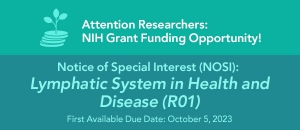Grants & Awards Programs

-
 Patient-Centered Outcomes Research Institute
Patient-Centered Outcomes Research Institute
About PCORI
PCORI is the leading funder of patient-centered comparative clinical effectiveness research in the United States.
The Patient-Centered Outcomes Research Institute (PCORI) is an independent, nonprofit research funding organization that seeks to empower patients and others with actionable information about their health and healthcare choices.What We Do
We fund patient-centered comparative clinical effectiveness research (CER) and research-related awards, issuing funding opportunity announcements several times each year.
Learn More > -
 Notice of Special Interest (NOSI): Lymphatic System in Health and Disease (R01)
Notice of Special Interest (NOSI): Lymphatic System in Health and Disease (R01)
This notice (#NOT-HL-23-099) was issued by National Heart, Lung, and Blood Institute (NHLBI), National Institute of Arthritis and Musculoskeletal and Skin Diseases (NIAMS), National Institute of Dental and Craniofacial Research (NIDCR), and National Center for Complementary and Integrative Health (NCCIH).
This NOSI aims to promote research on the normal biology of the lymphatic system (LS) and ascertain factors that account for individual differences in the LS impacting resilience. Also of interest is research to identify factors that account for individual differences in pathobiology and response to treatments, and understand the mechanisms and potential novel therapeutics for lymphatic diseases (LDs) and secondary heart, lung, blood, and sleep (HLBS) disorders related to lymphatic dysfunction. Further, this notice intends to stimulate lymphatic research at molecular, cellular, tissue, organ, and whole-body levels, and aims to facilitate research on innovations for identifying and intervening in LDs across the lifespan and disease states. The NOSI may also reach a broader community and facilitate multidisciplinary research needed to determine the function and role LS in health, disease prevention, and to identify biomarkers and test prevention and treatment strategies with specific attention to social determinants of health, and both treatment and health inequities.
This notice applies to due dates on or after October 5, 2023, and subsequent receipt dates through September 7, 2026. This NOSI expires on September 8, 2026; thus no applications will be accepted on or after September 8, 2026.
For more information, click here.
Learn More > -
 Lymphatic researchers needed for NIH Study Sections
Lymphatic researchers needed for NIH Study SectionsLE&RN was asked to recruit and has registered through the CSR portal in order to recommend potential reviewers. They have identified the following three Study Sections that review lymphatic grant proposals:
* Hypertension and Microcirculation (HM) Study Section reviews applications dealing with propulsion of lymph, lymphatic tone, and pathogenesis of lymphedema with more focus on functional studies; sometimes reviews applications about the lymphatic system in infection and inflammation depending on the outcome of research, namely whether focused on lymphatics or infection.
* Immunity and Host Defense (IHD) and Innate Immunity and Inflammation (III) Study Sections may review applications that address lymphatic role in infection.
* Cardiovascular Differentiation and Development (CDD) Study Section reviews applications involving lymphatic development, lymphangiogenesis, and lymphedema focusing on structure.If you are willing to serve on one or more of the above-identified NIH Study Sections, please contact LE&RN at LERN@LymphaticNetwork.org with the following information:
* Name
* Affiliation
* Study Section(s) on which you are willing to serve
* In 50 words or less, your qualifications for each Study Section selected
* Include CVInvestigators will not be able to review their own research or research on which they are collaborators. However, this will not prevent your research from being reviewed by the Study Section. Per NIH: If a researcher is on a Study Section and has an application, his or her application is reviewed by a special emphasis panel. This is a common practice that happens all the time. This should not be an obstacle to joining a Study Section.